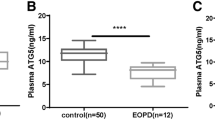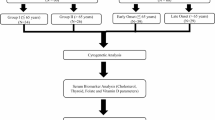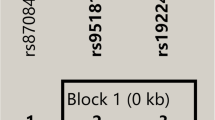Abstract.
Alzheimer’s disease (AD) is a devastating neurodegenerative disorder characterized by extracellular neuritic plaques and intracellular neurofibrillary tangles in brain parenchyma. Alpha-1-antichymotrypsin (ACT) is a component of plaque cores, can bind to Aβ, and has been proposed as a possible candidate gene for AD susceptibility. The genetic association between the ACT codon –17*A allele of the signal peptide polymorphism and AD has been shown in some, but not in all studies. One hypothesis is that the ACT codon –17*A allele is in linkage disequilibrium with unknown functional mutation(s) in the ACT gene. This study was undertaken to identify new mutation(s) in the ACT gene by PCR-SSCP-sequencing and, in conjunction with known mutations, to assess their role in affecting the risk of AD. A total of seven new point mutations were observed: 5′UTR(A→G), Asp128Asn(G→A), Ser250Ser(C→T), Leu301Pro(T→C), Thr324Thr(A→G), G→A in intron 4, and 3′UTR C→A. Of these, mutations at codon 250, codon 324, intron 4 and 3′UTR showed a frequency of 1% or more. Of the known mutations, Thr–17Ala(A→G), Lys76Lys(A→G) and Leu241Leu(G→A) occur at a polymorphic level. The ACT codon –17*A allele was associated with increased risk of AD (OR for AA vs TT: 1.71; 95% CI: 1.16–2.53; P=0.007), especially in the presence of the APOE*4 allele (OR for AA vs TT: 2.35; 95% CI: 1.13–4.85; P=0.02). The codon 241*A allele and the codon 250*T allele were associated with protective effects against AD (OR: 0.36; 95% CI: 0.13–0.86; P=0.02) (OR:0.39; 95% CI: 0.18–0.85; P=0.02). irrespective of the APOE*4 status. The codon 324*G allele was associated with a marginal protective effect (OR:0.57; 95% CI: 0.26–1.26; P=0.17). While the codon 241*A allele was in linkage disequilibrium with the codon –17*A allele, the codon 250*T and codon 324*G alleles were non-randomly associated with the codon –17*T allele. In contrast, the codon 76*G (OR:1.34; 95% CI: 0.92–1.95; P=0.13), codon 227*G (OR:3.96; 95% CI: 0.83–18.8; P=0.08) and intron 4*G (OR:1.47; 95% CI: 0.88–2.29; P=0.15) alleles were associated with a modest risk of AD, and all were in linkage disequilibrium with the codon –17*A allele. EH-based haplotype analysis showed that certain haplotypes are associated with either higher or lower risk of AD. Our data indicate that the ACT gene harbors several potentially important variable sites, which are associated with either an increased or decreased risk of AD. The non-random combination of risk and protective alleles may explain, in part, why the association studies regarding the ACT codon –17*A have been inconsistent, especially if the frequency of other ACT mutations varies between populations.
Similar content being viewed by others
Author information
Authors and Affiliations
Additional information
Electronic Publication
Rights and permissions
About this article
Cite this article
Wang, X., DeKosky, S.T., Luedecking-Zimmer, E. et al. Genetic variation in α1-antichymotrypsin and its association with Alzheimer’s disease. Hum Genet 110, 356–365 (2002). https://doi.org/10.1007/s00439-002-0697-3
Received:
Accepted:
Published:
Issue Date:
DOI: https://doi.org/10.1007/s00439-002-0697-3




